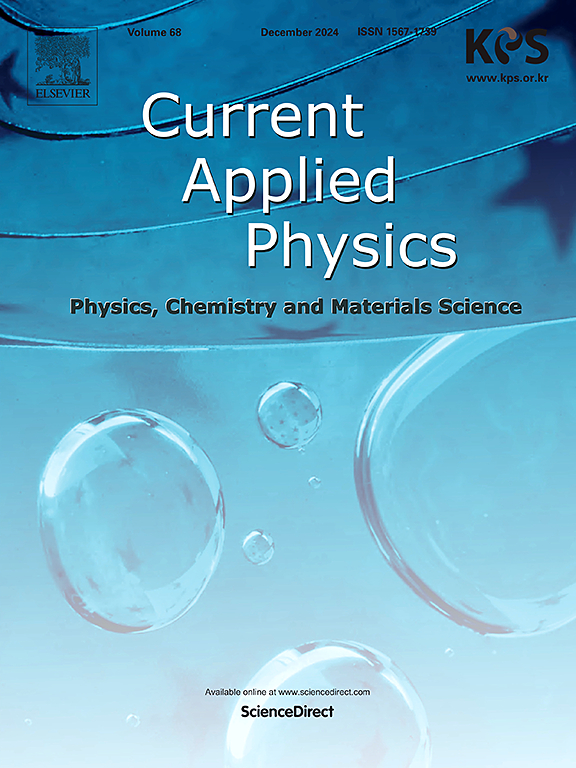CuInSn(S,Se)4薄膜的理化和光电性能及其在光电化学电池中的应用
IF 3.1
4区 物理与天体物理
Q3 MATERIALS SCIENCE, MULTIDISCIPLINARY
引用次数: 0
摘要
在这项工作中,采用自组织、易捕获沉淀技术在室温下合成了CuInSn(S,Se)4 (CITSSe)薄膜。通过检测In3+离子浓度,系统地研究了薄膜的理化和光电性能的变化。合成的CITSSe薄膜在光结构和光电子性能上均有显著改善。光吸收研究证实了直接允许跃迁,带隙能量在1.40至1.54 eV之间。x射线衍射分析证实了立方晶体结构的形成,而随着In3+离子浓度的增加,In3+离子从(220)到(511)的峰移表明In3+离子成功掺入到CITSSe基体中。从样品I0到I4,表面形貌发生了明显的变化,从纳米立方到纳米珊瑚。通过能量色散x射线光谱法确定了薄膜的元素组成。此外,利用高分辨率透射电子显微镜和选定的区域电子衍射图验证了五元CITSSe薄膜的纳米晶性质。采用双电极电池结构分析了光电化学和阻抗特性,其中裸露的CITSSe薄膜的光电化学效率最高,为0.61%,具有较低的电荷转移电阻。本文章由计算机程序翻译,如有差异,请以英文原文为准。

Evaluating physio-chemical and optoelectronic properties of CuInSn(S,Se)4 thin films and its photoelectrochemical cell application
In this work, CuInSn(S,Se)4 (CITSSe) thin films were synthesized using a self-organized, facile arrested precipitation technique at room temperature. The variation in physio-chemical and optoelectronic properties of the thin films was systematically studied by probing the In3+ ion concentration. The synthesized CITSSe thin films exhibited significant improvements in optostructural and optoelectronic properties. Optical absorption studies confirmed a direct allowed transition with a band gap energy ranging from 1.40 to 1.54 eV. X-ray diffraction analysis verified the formation of a cubic crystal structure, while a peak shift from (220) to (511) with increasing In3+ ion concentration indicated successful incorporation of In3+ ions into the CITSSe matrix. A notable modification in surface morphology was observed, transitioning from nanocubes to nanocorals from sample I0 to I4. The elemental composition of the CITSSe thin films was confirmed through energy-dispersive X-ray spectroscopy. Furthermore, the nanocrystalline nature of the pentanary CITSSe thin films was validated using high-resolution transmission electron microscopy and selected area electron diffraction patterns. Photoelectrochemical and impedance characteristics were analyzed using a two-electrode cell configuration, where the highest photoelectrochemical efficiency of 0.61 % was achieved for the bare CITSSe thin film, exhibiting low charge transfer resistance.
求助全文
通过发布文献求助,成功后即可免费获取论文全文。
去求助
来源期刊

Current Applied Physics
物理-材料科学:综合
CiteScore
4.80
自引率
0.00%
发文量
213
审稿时长
33 days
期刊介绍:
Current Applied Physics (Curr. Appl. Phys.) is a monthly published international journal covering all the fields of applied science investigating the physics of the advanced materials for future applications.
Other areas covered: Experimental and theoretical aspects of advanced materials and devices dealing with synthesis or structural chemistry, physical and electronic properties, photonics, engineering applications, and uniquely pertinent measurement or analytical techniques.
Current Applied Physics, published since 2001, covers physics, chemistry and materials science, including bio-materials, with their engineering aspects. It is a truly interdisciplinary journal opening a forum for scientists of all related fields, a unique point of the journal discriminating it from other worldwide and/or Pacific Rim applied physics journals.
Regular research papers, letters and review articles with contents meeting the scope of the journal will be considered for publication after peer review.
The Journal is owned by the Korean Physical Society.
 求助内容:
求助内容: 应助结果提醒方式:
应助结果提醒方式:


